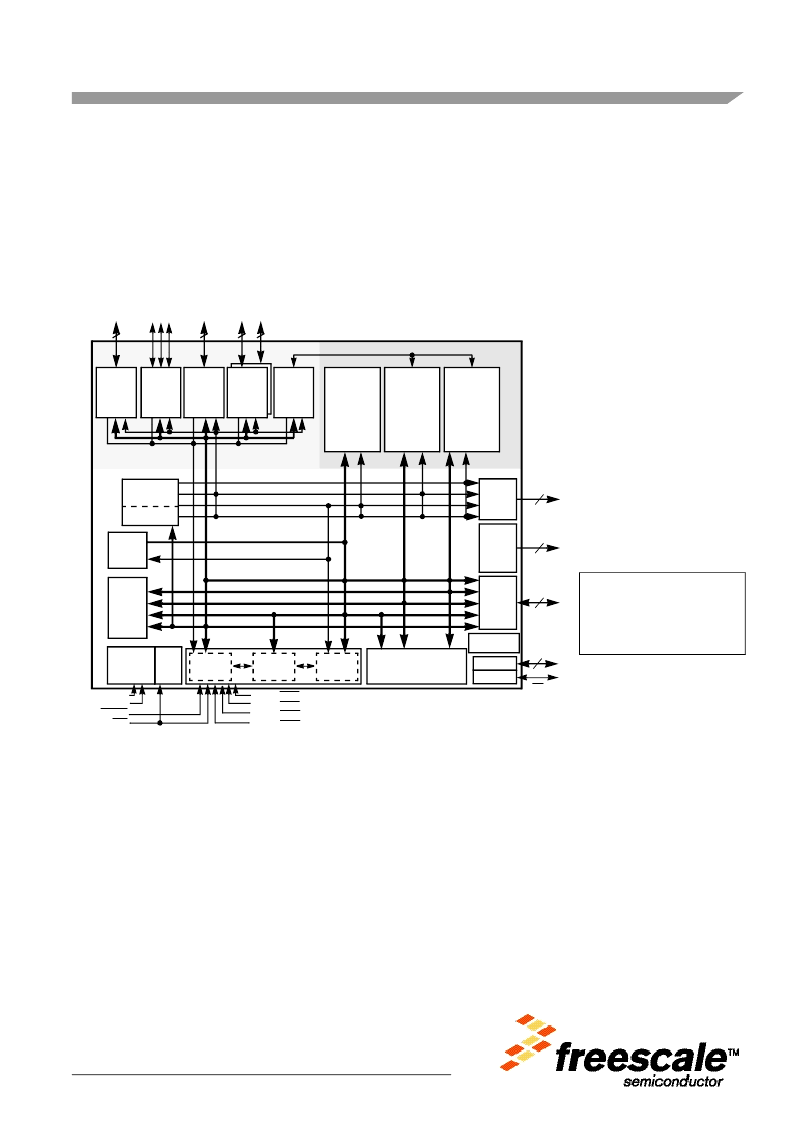- 您現(xiàn)在的位置:買賣IC網(wǎng) > PDF目錄377000 > DSP56321 (飛思卡爾半導(dǎo)體(中國)有限公司) 24-Bit Digital Signal Processor PDF資料下載
參數(shù)資料
| 型號(hào): | DSP56321 |
| 廠商: | 飛思卡爾半導(dǎo)體(中國)有限公司 |
| 元件分類: | 數(shù)字信號(hào)處理 |
| 英文描述: | 24-Bit Digital Signal Processor |
| 中文描述: | 24位數(shù)字信號(hào)處理器 |
| 文件頁數(shù): | 1/84頁 |
| 文件大?。?/td> | 898K |
| 代理商: | DSP56321 |
當(dāng)前第1頁第2頁第3頁第4頁第5頁第6頁第7頁第8頁第9頁第10頁第11頁第12頁第13頁第14頁第15頁第16頁第17頁第18頁第19頁第20頁第21頁第22頁第23頁第24頁第25頁第26頁第27頁第28頁第29頁第30頁第31頁第32頁第33頁第34頁第35頁第36頁第37頁第38頁第39頁第40頁第41頁第42頁第43頁第44頁第45頁第46頁第47頁第48頁第49頁第50頁第51頁第52頁第53頁第54頁第55頁第56頁第57頁第58頁第59頁第60頁第61頁第62頁第63頁第64頁第65頁第66頁第67頁第68頁第69頁第70頁第71頁第72頁第73頁第74頁第75頁第76頁第77頁第78頁第79頁第80頁第81頁第82頁第83頁第84頁

Freescale Semiconductor
Technical Data
DSP56321
Rev. 11, 2/2005
Freescale Semiconductor, Inc., 2001, 2005. All rights reserved.
DSP56321
24-Bit Digital Signal Processor
The Freescale DSP56321, a member of the DSP56300 DSP family, supports networking, security encryption, and
home entertainment using a high-performance, single-clock-cycle-per- instruction engine (DSP56000 code-
compatible), a barrel shifter, 24-bit addressing, an instruction cache, and a direct memory access (DMA) controller
(see
Figure 1
).
The DSP56321 offers 275 million multiply- accumulates per second (MMACS) performance, attaining 550
MMACS when the EFCOP is in use. It operates with an internal 275 MHz clock with a 1.6 volt core and
independent 3.3 volt input/output (I/O) power. By operating in parallel with the core, the EFCOP provides overall
enhanced performance and signal quality with no impact on channel throughput or total channel support. This
device is pin-compatible with the Freescale DSP56303, DSP56L307, DSP56309, and DSP56311.
Figure 1.
DSP56321 Block Diagram
YAB
XAB
PAB
DAB
YDB
XDB
PDB
GDB
MODB/IRQB
MODC/IRQC
MODD/IRQD
10
DSP56300
Core
6
16
24-Bit
24
18
DDB
Peripheral
Expansion Area
Y
X
P
P
6
5
3
RESET
PINIT/NMI
MODA/IRQA
EXTAL
XTAL
Address
Control
Data
Address
Generation
Unit
Six Channel
DMA Unit
Program
Interrupt
Controller
Program
Decode
Controller
Program
Address
Generator
24
24 Data ALU
→
56-bit MAC
Two 56-bit Accumulators
56-bit Barrel Shifter
Power
Management
EBus
Intand
IControl
Memory Expansion Area
DE
Program
RAM
32 K
×
24 bits
or
31 K
×
24 bits
and
X Data
RAM
80 K
×
24 bits
Y Data
RAM
80 K
×
24 bits
External
Address
Bus
Switch
SCI
EFCOP
ESSI
HI08
Triple
Timer
Instruction
Cache
1024
×
24 bits
Bootstrap
ROM
OnCE
JTAG
PLL
Clock
Generator
Internal
Data
Bus
Switch
External
Data
Bus
Switch
The DSP56321 is intended
for applications requiring a
large amount of internal
memory, such as networking
and wireless infrastructure
applications. The onboard
EFCOP can accelerate
general filtering applications,
such as echo-cancellation
applications, correlation, and
general-purpose convolution-
based algorithms.
What’s New
Rev. 11 includes the following
changes:
Adds lead-free packaging and
part numbers.
相關(guān)PDF資料 |
PDF描述 |
|---|---|
| DSP56321VF200 | 24-Bit Digital Signal Processor |
| DSP56321VF220 | 24-Bit Digital Signal Processor |
| DSP56321VF240 | 24-Bit Digital Signal Processor |
| DSP56321VF275 | 24-Bit Digital Signal Processor |
| DSP56321VL200 | 24-Bit Digital Signal Processor |
相關(guān)代理商/技術(shù)參數(shù) |
參數(shù)描述 |
|---|---|
| DSP56321EVM | 功能描述:開發(fā)板和工具包 - 其他處理器 DSP56321EVM RoHS:否 制造商:Freescale Semiconductor 產(chǎn)品:Development Systems 工具用于評(píng)估:P3041 核心:e500mc 接口類型:I2C, SPI, USB 工作電源電壓: |
| DSP56321EVMUM | 制造商:未知廠家 制造商全稱:未知廠家 功能描述:DSP56321 EVM User's Manual |
| DSP56321FC200 | 制造商:Freescale Semiconductor 功能描述:HIP7 56321 200MHZ DSP - Trays |
| DSP56321FC220 | 制造商:Rochester Electronics LLC 功能描述:- Bulk |
| DSP56321RMAD | 制造商:未知廠家 制造商全稱:未知廠家 功能描述:DSP56321 Reference Manual Addendum |
發(fā)布緊急采購,3分鐘左右您將得到回復(fù)。